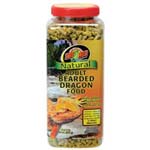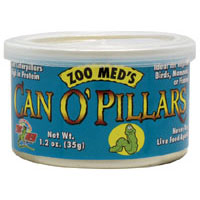Commercially-prepared diets for reptiles have become quite popular lately, but we do not have long-term research concerning the value of most. However, when used with care, some can simplify the feeding of certain species while contributing to their health. Reptomin, for example, is used in many major zoos, and I relied upon it heavily during my years working at the Bronx Zoo’s Reptile House. Success with commercial diets is a matter of choosing one produced by a well-respected company, and pairing it with natural food items in the proper proportions. Today I’ll review one such product now marketed by a leader in pet reptile nutrition, Zoo Med’s Bearded Dragon Food (Adult and Juvenile).
 The Evolution of Prepared Diets
The Evolution of Prepared Diets
The Inland Bearded Dragon, Pagona vitticeps, is likely the world’s most popular lizard pet. Yet this fascinating lizard was virtually unknown in the USA, even in zoos, not long ago. Indeed, many lizard enthusiasts are surprised to learn that all pet trade animals seem to have originated from a small group smuggled out of Australia to Germany in the early 1980’s (please see this article for further information).
Due to the great interest in keeping and breeding this species, hobbyists and pet supply companies have researched its captive husbandry quite thoroughly. As a result, we now know have a very good understanding of the Bearded Dragon’s dietary needs, health care and reproduction (please see articles linked below). An interesting offshoot of this work has been the formulation of several prepared Bearded Dragon diets. Because of the care and research that Zoo Med puts into all of its products, and the company’s outstanding reputation among professional zookeepers and private hobbyists alike, I favor the Zoo Med’s formula over others.
Using Bearded Dragon Pellets
Zoo Med Bearded Dragon Food is not intended to be used as the sole diet for either adult or juvenile lizards. Rather, it is best viewed as a nutritious part of a well-balanced and varied diet.
The product is in pellet form, and contains 24% protein. Fiber and calcium are also included. Young Bearded Dragons – up to age 12 months or so – are highly carnivorous in the wild, and likely need comparatively more protein than do adults. A wide variety of insects should be offered…canned insects mixed into a dish with pellets may encourage them to try the new food.
Adults include a good deal of plant material in their diet, and seem to take readily to the fruity taste of Zoo Med Pellets. Moistening the food and adding a favorite vegetable will increase acceptability. Please see the articles linked below, or post any questions you may have, if you’d like detailed information on feeding bearded dragons.
Important Ingredients
I was happy to see that a number of highly nutritious vegetables and greens are used in the preparation of Zoo Med’s product. Several of these, including kale, mustard greens, dandelion, and collard greens, formed the basis of the herbivorous reptile salad I used at the Bronx Zoo.
 It is not recommended that one add powdered vitamins and minerals to Zoo Med Bearded Dragon Pellets, but I would continue to use these on other foods. My favorites are ReptiCalcium and ReptiVite. Please post below for further information.
It is not recommended that one add powdered vitamins and minerals to Zoo Med Bearded Dragon Pellets, but I would continue to use these on other foods. My favorites are ReptiCalcium and ReptiVite. Please post below for further information.
As usual, Zoo Med has posted detailed nutritional information about this new product. You can view the ingredients list here.
Further Reading
Bearded Dragon Health: Atadenovirus or Wasting Disease
 That Reptile Blog – Reptile, Amphibian and Exotic Pet Care and Information
That Reptile Blog – Reptile, Amphibian and Exotic Pet Care and Information





Wish that I could get a bearded dragon 🙁 They’re adorable and I’d love to have a lizard that is fairly docile.
Last year my boyfriend let me pick out a birthday present at the pet store, but discouraged me from getting one and I ultimately chose a leopard gecko. Definitely don’t regret getting it, because it’s super cute and has a lot of personality, but it definitely isn’t content sitting on a lap haha.
Maybe someday 🙂
Hi Paul,
Leopard geckos are a good choice if you are just starting out…smaller, very hardy, no need for UVB, less temperaure-sensitive. Personalities vary…some bearded dragons resist handling, especially when young, and some leopard geckos are fine with it.
Diet is critical for leopard geckos…mealworms and crickets alone will not keep them healthy long-term. Please check out this article (has 2 parts) and let me know if you need any further info. Here are a few others that you might enjoy as well:
Leopard Geckos in the Wild
The Ideal leopard Gecko Terrarium
Enjoy, Frank
Hello Frank 🙂
Thanks for the additional links to leopard gecko diets – I too am a proud owner of a gorgeous six year old leo 🙂
However, I recently adopted a five year old bearded dragon from a young (and I’m guessing relatively inexperienced) owner, who reassured me that the beardie was extremely keen to eat a variety of greens, with the odd insect as a treat. I don’t think he was being entirely honest as my new pet hasn’t touched cucumbers, rocket, apples etc. that I have presented to him over the last few weeks. He does eat mealworms very enthusiastically though. Would you have any tips to share with me in order to encourage him to eat properly?
Thanks for taking the time to read this,
Naomi
Hello Naomi,
My pleasure…
It may be difficult to change the animal’s diet if it has been taking mainly insects for several years; try keeping him hungry for several days (a 5-7 day fast will do no harm, and works wonders for the appetite) and then offer a mixed salad with just 1-2 mealworms tossed in to attract his attention. Some ideas for vegetables/greens that may be tried can be found in this article.
mealworms should only be used on rare occasions; linked to intestinal blockages and are not great, nutrition-wise (please see this article for hints on use). A wide variety of insects should be offered; please see this article.
Please let me know how all goes, best, Frank
Hello Frank
Hello Frank, just a quick update on my beardie Dexter 🙂
He is now eating greens! He is enthusiastically getting through bowls of kale, carrots and rocket, as well as dandelions from my parents’ garden. I’m ecstatic about this as I’ve spent hours sneaking bits of green into his mouth before he licks up an insect, gradually getting him used to flavours he obviously never experienced.
I began to leave bowls of misted greens with some worms in his tank, only to return to empty bowls! Initially I wouldn’t let myself believe that Dexter actually ate veg voluntarily, but I had to accept the fact that there was just too much veg there for the mealies to eat 🙂
I definitely agree with your post on mealworms causing impaction, as I needed to bathe him in warm water and massage his belly for stools to pass, but now he’s defecating at least twice a week by himself. I still give him baths though 😀
Would you have any suggestions for a breedable worm I can readily give him that you may think I can get hold of in Ireland?
Thanks so much for your help 🙂
Naomi
Hello Naomi,
Thanks for the update and glad to hear of your success!
I do not have any direct contacts near you; silkworms and butterworms (both caterpillars) are excellent, as are phoenix worms (Soldier fly larvae) and lab-reared housefly larvae. None are easy to breed on your own, but check for local distributors. Please see the following for more info:
http://blogs.thatpetplace.com/thatreptileblog/2011/10/18/black-soldier-fly-larvae-calciworms-as-food-for-reptiles-and-amphibians/#.U4ILNygnUpo
http://blogs.thatpetplace.com/thatreptileblog/2010/03/08/houseflies-and-maggots-as-food-for-reptiles-amphibians-and-invertebrates/#.U4ILYSgnUpo
Enjoy, best, Frank
Hi Frank,
I have a couple of questions. What is a 20% to 80% ratio for greens to insects suggested for juvenile beardies? My 6 month old beardies have all the sudden stopped eating crickets and love the meal worms and collard greens. I give them 18-20 worms and 18-20 bite sized pieces of CGs. They are both around 12-13 inches long. Is this OK? Also, I purchased some Zoo-Med pellets and it says to moisten. Do I use a spray bottle and give them a couple of squirts? Please advise.
Thanks, Tim
Hello Tim,
Offer greens, but no need to worry about specific ratios. Young individuals consume mainly invertebrates, adding greens to the diet after age 1 year or so. More important at this age is to provide a variety of insects and ample vitamin/calcium supplementation (and UVB exposure). Avoid mealworms other than white (newly-molted) grubs. It is common for them to reject certain items that are fed continually…may have to do with natural regulation of nutrient needs. Try offering the insects mentioned in this article, along with silkworms, calci-worms, hornworms (available online). Also try adding some of the produce/greens listed as well.
Yes, fine to spray the pellets…these provide plant-based nutrients as well as protein.
Please let me know if you need more info, best, Frank
Hi Frank,
Thank you for your timely responses. Another question. I have been feeding them wax worms as well as meal worms. They really like the wax worms. I have read to feed them until they stop eating, however when the defecate I notice undigested worms. Is this common? Should I give them less? Please advise.
Also, please explain “Avoid meal worms other than white (newly-molted) grubs”
Thanks, Tim.
Hi Tim,
My pleasure. Waxworms have a thick exoskeleton…that is what you may be seeing; they are best used as an occasional food item, not a staple. Blockages have been linked to steady use, I believe.
Mealworms are white in color for a time after molting. to obtain these, you’ll need to set up a colony. The pupae are also useful. But again, in limited amounts. Please see this article, enjoy, frank
Hi Frank,
My 2 beardies are now approaching 8 months old. Lately one has not eaten much and sleeps a lot. I read about brumation and it appears that may be what he is doing. The other eats more often but they both do not go crazy and scarf like they did a few months ago. I looked for other food sources at pet stores but most only have meal worms and wax worms. One will dine occasionally on crickets as well, the other as I said does not have much of an appetite. Any suggestions.
Thanks, Tim
Hello Tim,
The species listed under “Commercially Available Inverts” in this article are available online..they usually refuse earthworms, but accept most others.
Offer mixed greens also, although younger animals tend to favor insects.
Some do slow down in winter, even if kept warm, but check your nite-time temps, as this can affect appetite, and be sure your basking site is hot enough. Let me know if you need more info, best, frank